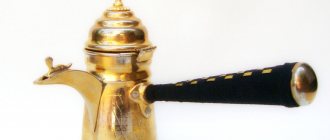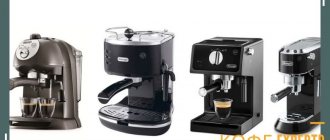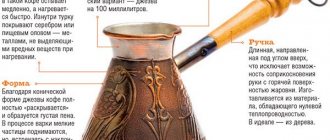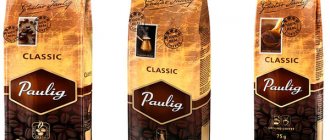There are many devices that make it possible to brew aromatic espresso. Even automated coffee machines have been invented that allow you to prepare a coffee drink with a minimum of effort. At the same time, classic recipes involve the use of cezve and turk. The difference between coffee brewed in such a container is immediately noticeable. It acquires a refined taste and a distinctly noticeable aroma.
A little history
The vessel with the unusual name ibrik is called the first utensil for brewing coffee. At its core, this is just a beautiful jug. Its long spout is good for pouring hot liquid, and the design itself holds up well to being carried over long distances in bags. Typically, ibriks were not made large - their volume did not exceed 300 ml. But nothing prevented them from being large in size, since they could be used to store water.
They were replaced by dalla . It became popular during the import of coffee to Arabia. In those years, it ceased to be considered a drink of common people and confidently entered the diet of rich people.
That is why the dalla, although it was also an ordinary jug, looked much richer, more picturesque, and more luxurious.
Its main differences were the hammered pattern and the material itself - metal instead of clay. In addition, dalla was used exclusively for coffee, and not for water. Gradually they began to make it in a cone shape, and thus the cezve we got, which we are all accustomed to today.
After some time, another interesting device was invented - a percolator . This is what the inventor (a French priest) named it from the word percolare - “to seep through, penetrate.” The whole structure consisted of two parts and worked quite simply. Ground coffee was poured into the upper bowl, in the walls of which holes were made, and boiling water was poured over it generously. The liquid seeped into the lower container already saturated, that is, in the form of a tasty, invigorating, aromatic drink.
What are the main differences between cezve and Turkish
Ibrik is the first utensil for making coffee, the name comes from the Persian phrase “water” and “to pour”. The main feature is the long nose, which makes it convenient to pour the drink into the cup.
Ibrik, the first utensil for making coffee, comes from the Persian phrase “water” and “to pour.”
Over time, the ibrik was replaced by a new device - the dalla. This happened at a time when the drink became more popular and began to be used in high circles of Arabian society. In appearance, it was a jug with an elongated neck with beautiful embossing and a small spout. The main difference from its predecessor is the metal structure, while the previous copy was made of clay.
Dalla's appearance was a jug with an elongated neck, beautiful embossing and a small spout.
Before you find out how a Turk differs from a cezve, you need to know the history of their creation and popularization. When coffee gained immense popularity in Turkey, a traditional and well-known product was invented - cezve.
This kitchen utensil owes its appearance to the need to brew small portions of coffee, since large volumes of coffee drink were brewed in dall. Turka is the same product, but this is the name that took root in Russian society many centuries ago.
This kitchen utensil owes its appearance to the need to brew small portions of coffee, since large volumes of coffee drink were brewed in dall.
In order not to get confused in the purchasing process, cezve or turk, remember: these are two names for one item.
Which Turk is better to brew coffee in?
Devices vary in shape, material, size. Amount of liquid held: 70 – 500 ml. The drink can be prepared for a group by choosing the largest container, but the coveted foam will not be enough for the whole family, so it is better to use several small containers.
For those who value the preservation of fatty oils, professionals recommend choosing tall containers. The water boils slowly, and it is difficult to miss the rise of the coffee cap. Prolonged foam growth occurs naturally due to the shape and height. They are divided into types:
- conical - heats the contents more evenly, and the narrow neck allows you to form a “plug” on the surface and, most importantly, prevent intense bubbling;
- cylindrical - heating occurs less evenly than in a conical pot, and mistakes made during cooking threaten damage to the finished product;
- barrel-shaped - the material for such models is often selected from clay, where the drink continues to languish even without heating.
It is difficult to clearly answer the question of what kind of Turk should be. Everyone’s preferences are different, but the rich abundance of containers for preparing everyone’s favorite coffee allows you to choose a model that will satisfy your personal requirements.
Where is the best place to brew coffee?
Currently, there are quite a few varieties of coffee: granulated, powdered, brewed, whole, ground. Each of them is designed for brewing in one way or another. There is no particular difference in which Turk to choose; they differ only in shape, the material from which they are made, and the ratio of the diameter of the bottom and neck.
If you choose between a coffee maker and a cezve, there are a number of pros and cons. True connoisseurs of Americano choose the manual method of cooking, which results in an individual taste.
True connoisseurs of Americano choose the manual method of cooking, which results in an individual taste.
Coffee ground 15 minutes before cooking has the full range of taste and aroma qualities.
A significant plus is the price; a Turk is several times cheaper than a coffee machine and takes up much less space in the kitchen. Of course, it is easier to care for a cezve than a whole coffee-making apparatus.
A Turk is several times cheaper than a coffee machine and takes up much less space in the kitchen.
The downside is time; cooking in Turkish requires skills and constant supervision, otherwise the coffee tends to run out onto the tile or be spoiled. The manual method is not suitable for large companies; it only takes a couple of servings. Another feature of the cezve is that it is not suitable for most stoves; a special adapter for the induction surface and a diffuser for gas burners are required.
What is a cezve
Cezva is a Turkish word that means “hot coal”. This is the name of a special vessel for brewing coffee powder. It is a container with a wide bottom, a narrow neck and a long handle.
Traditionally made of copper and with an interior lining of food-grade tin or silver (on more expensive models). Copper forms soluble compounds that are harmful to our body, and the internal coating prevents these compounds from forming.
Before using a copper cezve, be sure to check the condition of the inner coating; if the copper is visible, the cezve needs to be changed.
Cezves are made from stamped and forged copper. Stamped cezves are thin-walled. This does not have the best effect on making coffee, but their prices are much lower. Heavy forged cezves are traditional. They have a thick, massive bottom and strong walls; on the outside, as a rule, they are decorated with applied embossing.
Copper cezves have been used to make coffee on sand (in Turkish) since ancient times. To do this, a metal baking sheet is filled with river sand and pebbles and placed on the fire. After 1.5 - 3 hours, the sand becomes hot and the coffee in the cezve is placed on it. The result is an aromatic drink that cannot be prepared in coffee machines. This brewing method is called classic.
What are dalla and ibrik
Ibrik is an ancient Arabic water jug. The first to use it for brewing coffee were the nomadic Berber tribes. Ibrik was a large copper vessel with a lid, had a long thin spout, a wide base, a narrow neck and a curved handle. It was very convenient to brew coffee over a fire in it. Over time, they began to use other utensils for making coffee, and the ibrik is still used today in eastern countries as a jug for water, but no one brews coffee in it anymore.
Dalla is widely used for brewing coffee in Syria and Saudi Arabia. This dish appeared as a result of a slight modification of ibrik. A dalla is a small vessel with a lid, a short spout and a long straight handle. It is made mainly of copper, has a wide thick bottom and a narrow neck.
In the East, red tea is called a cure for all diseases, giving vigor and strength. You can find out the benefits of hibiscus tea in our publication.
White tea is a drink that contains epigallocatechin, which can protect against cancer. You can read about the benefits and harms of white tea here.
Do you like tea because it has a beneficial effect on the body? Have you ever wondered how many calories are in tea and is it healthy to drink tea with sugar and other additives? You can find out about the calorie content of tea with sugar here: https://chay-i-kofe.com/chay/informaciya/kaloriynost-chaya-s-saharom-i-bez/
How does a Turk differ from a cezve?
So, ladles designed for brewing coffee are called turks or cezves. In fact, the only difference is in the name. This is the same container, it’s just that its true “name” could not take root in Russia. It seemed very difficult to pronounce. In other countries the name “cezva” is also not always used. It is known in the world as serjep and fainjan.
True, among coffee lovers there are those who are convinced that there is still a difference between these two vessels.
The difference is that the neck of the cezve is significantly narrower and longer. In Turks, the shape of this part is funnel-shaped.
Where was the cezve used?
Coffee cezve - what is it and where did it first appear? It came to Turkey from the Middle East along with coffee beans. The local merchants did not miss the opportunity to sell another product, but thanks to the Turks it became known throughout the world. They created their own, incomparable coffee cezve recipes.
Rich families used dishes made of silver or copper, which emphasized status. The poor brewed coffee in thick-walled clay products. These are the ones that make the best drink, because the grounds take a long time to heat up evenly and release aromatic substances.
Cezve, as the coffee pot is correctly called in the East, must have the correct diameter ratios. For example, the neck is half the size of the bottom. This is necessary so that the foam tightly closes the neck and prevents the aroma from evaporating. The word itself means “hot coal,” indicating how nomads prepared hot drinks.
Previously, coffee was brewed in large containers such as ibrik. A cezve is a small vessel designed for 1 – 2 people. This is its convenience - you don’t need to waste a lot of grains and water.
What a cezve is and how to use it correctly can be observed in oriental restaurants and cafes where they do not use other methods of brewing coffee - for example, by machine. The principle is that sand is first heated in a large container, and then the cezve is placed in it. In theory, the entire body should be placed in sand up to the neck. This allows the liquid and grains to be heated evenly.
History of the name Turki
Why is a Turk called a Turk? This name was already given to her by Russian sailors and merchants who transported goods from the East. Without thinking for a long time, they christened it after the name of the country from which it was brought.
The history of Turks for coffee ends here. Since the conical shape of this product was invented, it has not changed. Nowadays, various materials are used. Mostly clay is popular, like the ancient Bedouins. To prevent the handle from heating up, it is made from other materials – often wood.
We can say that cezva and turk appeared simultaneously, but were named differently by representatives of different nationalities. It doesn’t matter what the correct name for the device is – Turk or Cezve. Both options are correct.
Many people see the difference between a Turk and a cezve in the design of the device. On sale you can find dishes decorated with oriental motifs, complete with cups made of the same material. Decorations are the only thing that distinguishes a cezve from a Turka. People prefer to call such cutlery an oriental term. While ordinary ceramic dishes are called Turks.
Materials for making Turks
To make a cezve, Turks use several materials:
- copper or brass;
- silver;
- clay;
- stainless steel
Copper products are coated with a layer of tin to prevent metal oxides from entering the body. This is one of the first materials used in ancient times. Only rich people could afford silver dishes. The poor used clay, firing it in ovens.
Video: Coffee utensils at the Turkish bazaar
Now you can find high-quality and durable Turks made of stainless steel, fire-resistant glass, and non-stick coating. The main thing is that the material is safe and does not change the taste of the coffee.
What is Turka
Turk is a special vessel for preparing coffee powder with a narrowed, funnel-shaped neck, wide bottom and long handle. It is made of both copper and: ceramics, stainless steel, brass, clay and other materials.
The word “Turk” itself was invented in Russia. The thing is that the name “cezva” did not take root there, so they began to call it Turk, as a sign of the popular preparation of coffee in Turkish (on sand). By and large, turk and cezve are different names for the same utensils for brewing coffee.
Why did the cezve come to be called the Turk?
In Russia, coffee is traditionally brewed in a Turkish pot, and few people wonder why this is the name of a vessel that is so similar to a Turkish cezve. There are two points of view on the origin of this term.
Most archaeological scientists believe that there is no difference between a Turka and a cezve, and that the term “Turka” simply entered into use among the Russian people as a word that is easier to use than the foreign “cezva.”
Since coffee appeared in Turkey much earlier than in Russia, Turkish merchants had to take the cezve with them on voyages to enjoy their favorite drink away from home. Over time, coffee began to gain popularity in our country, and the utensils for preparing it began to be popularly called “Turks” - after the nationality of the people who so actively use it. But in essence, these two devices are no different from each other.
Experts say that cezves are made from copper, and Turks are made from any other materials
Adherents of the second point of view argue that the Turk is a type of cezve and has a wider and shorter neck. Also, cezves are traditionally made from heavy forged copper, but Turks can now be found - in addition to copper - from steel, aluminum, brass and even ceramics.
Which Turk to choose for coffee
Turks are made from different materials, and the brewing technology and taste of the drink depend on their quality. Apply:
The most popular varieties have their own advantages over others, and their properties have long been appreciated by coffee lovers. Among the wide variety, a reference group stood out.
- Copper Turk. It differs from other modifications in its high thermal conductivity, so the vessel heats up more evenly even on a regular stove, not to mention sand.
They are cast and can consist of only two fragments, and if someone wants to choose the right Turk, then only a solid device provides both durability and delicious taste. The copper vessel can be a thick or thin device. Thin-walled devices are usually purchased as souvenirs, the edges are often cut off, they are elegant, but the decorative designs are unclear. For everyday use, buy from dense metal:
- with special processing around the edges;
- thick bottom;
- with a noticeable difference in size between the throat and bottom
Models, as a rule, have a healthy coating made of stainless steel, silver, and tin. The consumer’s task is not to damage the inside of the vessel and to ensure that scratches and chips do not form. A container forgotten on the stove melts the tin coating, and the vessel becomes unusable. Careful handling helps avoid trouble. There are people who are convinced that regular rinsing with water creates a coffee residue over time, and this contributes to a juicier taste of the drink.
- Aluminum Turk. Its thermal conductivity is significantly lower in relation to copper vessels, but this does not interfere with uniform heating. Turks made of aluminum are unpretentious, safe, and the only drawback is their simplicity of appearance. They are cheap, durable and do not require special care. Often there are models with an irregular shape, due to which some of the aroma is lost.
- Steel Turk. It heats up unevenly due to low thermal conductivity. With a hot bottom, the body remains cold for some time. Their throat is usually wide, and the taste is less pronounced. The main advantage of steel models is their reliability, low cost, and ease of maintenance. Manufacturers often make such vessels of irregular shape, which deteriorates the quality of the drink.
- Ceramic group. The clay pot impresses with the extraordinary results of the coffee it produces. The porous material allows air to pass through, and thanks to this quality, it draws out all the most valuable things from the powder.
The peculiarity of clay vessels is their “age”: the older they are, the deeper the nuances of the finished product. For lovers of real taste, it is better to purchase clay Turks. Possessing powerful thermal conductivity, ceramic products heat up slowly and continue to simmer the contents after cooking. - Quartz group. They are transparent, the cooking process is always visible, this allows you not to miss the moment of boiling. Crystal models differ from copper or brass cookware in that they do not oxidize, conduct heat no worse than ceramic coffee makers, and this makes them a winner in the Turkish series.
What factors influence the taste of Turkish coffee?
You can get a wonderful drink thanks to a successful ensemble of shape and material, but in order to prepare a real masterpiece in the oriental style, such indicators as:
- grain type;
- cooking method;
- amount of powder (the more it is, the richer the finished product);
- seasonings are essential additives that affect taste;
- brewing time - radically changes the density of the extracted substances.
The most difficult task is preserving aromatic oils. They form the coffee film, influence the taste and prepare the receptors for the perception of the magical fragrance. If the foam cannot be preserved as a solid film, this leads to undesirable changes in aroma. The drink turns out bitter. Coffee like
What other devices are there for brewing coffee?
There is more than one vessel for brewing coffee. Among the ancient dishes, the following are distinguished:
The history of coffee began about a thousand years ago, and they began to brew it in hot water 8-9 centuries ago. It is clear that this required dishes. The first were unassuming kettles and saucepans, but soon the wandering Bedouins adapted special jugs - ibriks - for preparing the drink. Experts and ethnographers claim that their origin is so ancient that it evokes awe and reverence.
Ibrik
The word is of Arabic origin (according to some sources - Persian). Composed of two words - “water” and “pour”.
It is believed that it was the ibrik that became the first coffee utensils. In essence, this is a simple Bedouin jug that could be carried for travel and hold a minimal amount of liquid. Archaeologists have also found stationary ibriks that could mix up to 100 liters of liquid. Of course, coffee was not brewed in such containers, but used for water or wine.
A special feature of the ibrik was its long spout, through which it was convenient to pour hot liquid.
Another feature was the round sides, offset towards the bottom. They provided capacity and stability.
Despite its reputation, after a couple of centuries the ibrik had to make way for a new container for coffee called the dalla.
Dalla
In the vastness of Syria, a vessel called dalla was popular. This is, in fact, a modified version of irbik. The spout of the ladle is short, and the handle is straight and elongated. The bottom of the container is thick and wide, and the neck is narrow.
The use of dalla became popular when coffee drinks began to be consumed not only by nomads, but also by wealthy people. The dishes looked luxurious. It was decorated with chasing.
Elegant containers were found in the homes of nobles and merchants. Ordinary people were content with simpler versions of these vessels.
The difference between dalla and irbik was the purpose of the jug. The first option was used only for making coffee, while the second could be used to pour various drinks. Archaeologists even managed to find an irbik with a volume of one hundred liters. Naturally, it could not be used to make coffee. Wine or water was poured into such a jug.
Dalla - another vessel for brewing coffee
Dalla – used for making coffee in several areas of Syria, Yemen and Saudi Arabia. It is a small saucepan with a curved spout and a long handle. Its shape resembles a closed cezve, as it has a wider bottom and a slightly narrowed upper part. The design is very successful, because if you leave the dalla on the fire, coffee will begin to flow through a long spout, where you can easily place a cup.
Dallah comes from an Arabic jug called irbik. Traditionally it was used to store water and coffee was first brewed in it. If you look at it, you can see a shape similar to the cezve and dallah, namely a wide bottom and a narrow top, only the spout is on the lower part of the vessel. So they moved it up, and it turned out to be a dalla. Today, irbik is used in Arab countries for its intended purpose - no one brews water and coffee in it anymore.
Jebena
Jebena is the closest relative of the ibrik. The Ethiopian jebena (Fig. 3) is a squat ceramic jug with convex sides, a narrow neck and a spout slightly shorter than that of the ibrik. A horsehair filter is placed at the base of the spout to retain the grounds.
The Eritrean jebena (Fig. 4) differs from the Ethiopian in the absence of a spout. It is replaced by a groove on the neck. Coffee brewed in a jebene is poured into tiny ceramic cups called finjans.
Ethiopian jebena
Eritrean coffee ceremony. Woman pouring coffee from a jebena into a finjan
Local potters sell black and red (or brown) jebens. Black jugs are fired and ready to use. But coffee connoisseurs prefer to buy red, unroasted jabens. Spent coffee is thrown into such a vessel, filled with water and put on fire. After boiling for 1–2 hours, the inside of the jebena becomes saturated with the aroma of coffee and turns black.
Ceramic jug
In France in the eighteenth century, an extraordinary device was invented in which coffee was brewed. It was a jug made of ceramics. A plate resistant to high temperatures was placed on its bottom. Coffee drink lovers used this utensil for a very long period.
Percolator
After some time, the French archbishop invented the percolator. The name of this device comes from the word percōlāre, which translates as “seepage.” The mechanism worked on a simple principle. A vessel with small holes made in the walls was placed in the upper part of the structure and coffee was poured into it. After this, boiling water was poured into the dishes. Thus, in the lower part of the structure there was an invigorating drink.
Turka (aka cezve) is a unique jug that has continued to be used for a huge number of years to obtain an aromatic invigorating drink. Recipes change, different coffee varieties are used, but this tableware remains in demand. Many true coffee lovers do not accept other devices and are convinced that truly aromatic and tasty coffee can only be prepared in such vessels.
Turk (cezve). History of creation
The date to which the preparation of the first coffee drink could be attributed is lost in the centuries. But the history of the vessel in which coffee is now brewed by the Turks and coffee pots is three centuries closer to us and, for this reason, is well known. Since ancient times, coffee was brewed by African tribes. This drink was considered illegal, so they drank it secretly. Bronze or copper pots - this is what the first coffee pot looked like. Coffee was made over a fire, after which these containers were hidden. The tribes themselves, persecuted by strife on religious grounds, were forced to withdraw from their acquired place.
Those who joined the Bedouin nomads could only afford long-necked jugs for water. They began to brew coffee in them; other utensils for coffee were simply not considered, since there were neither the capabilities nor the means for it. Bedouins still brew it in similar jugs to this day, calling them “dalle.” Another part of the Africans went to the Arabian Peninsula, accompanied by eastern merchants. The secret of making coffee may have been the Africans' payment for a successful voyage. One way or another, the traders liked the new drink so much that they considered it worthy of the Sultan himself.
The Lord also liked the coffee. This drink was prepared in a small golden saucepan equipped with a long handle and a lid. These precautions were necessary so that no one's breath could defile the drink of the gods.
The taste of the coffee was so tart that the Sultan was afraid not to recognize the poison in the drink. Therefore, the drink was prepared in his presence. The gold heated up quickly, and the moment of boiling was difficult to detect. Coffee burnt on coals spoiled the impression of the drink as a whole, overshadowing its aroma.
The craftsmen were tasked with coming up with a new form of vessel for brewing coffee. The material chosen was tinned copper - a much slower heating material. The shape of the vessel was also changed. It became narrow at the top and wide at the bottom. The narrow neck widened at the top, which made it possible to catch the moment the drink boiled. The silhouette of the vessel resembled the figure of an oriental woman. However, they left the long handle. It is interesting that no one invented coffee cups separately, on the occasion of the appearance of a new drink.
The new container for making coffee began to be called “rakva” after the name of a rich nobleman who began to make and sell these vessels. As for the Sultan, he was so happy that he ordered that all his entourage be treated to a magnificent drink. There was a big feast, a dish of sweets, fruits and, of course, a new coffee set consisting of rakva and cups, which the Sultan was so proud of. This idea undoubtedly added to the popularity of coffee. Over time, the name “rakva” was forgotten, and the vessel began to be called “dzhezva”.
This was the name given to the container for brewing coffee by Europeans, to whom the culture of drinking coffee came from the East. Coffee was brought to Russia from Turkey. While it was drunk exclusively in the families of aristocrats and other representatives of the wealthy class, the name “cezva” was retained. As soon as coffee became public knowledge in Soviet times, they did not break their tongue and, without hesitation, came up with a new name for “cezve” - “Turk”, i.e. came to us from Turkey.
To this day, this name remains with the vessel in which a wonderful drink of truly divine origin is brewed. The craftsmen decorated the Turks in every possible way with embossing, patterns, slightly modified the handles, and even the very shape of the dishes, but the essence always remained the same. The Home Boutique online store offers many interesting options for Turkish pots and other coffee utensils, made in different styles from a variety of materials. Take a look at our website and see for yourself.
Interesting facts about the Cezve Turks
There are many funny and instructive stories associated with this dish.
- In the countries of the Middle East, the wealth of the owner could be determined by the cezve. In rich houses, coffee was brewed in silver vessels, for everyone else there was copper and its alloys, and the poor used a clay pot.
- It is believed that Turku was invented in Turkey, but this is not so. She came to this country along with coffee. The Turks simply spread the dishes around the world, again, along with coffee and their own recipes for its preparation.
- After the inventor of the cezve presented it at the court of the customer-sovereign, he, as a reward, gave the right to monopoly trade in the new product to its creator. This permission brought a fortune to the savvy vizier, who came up with the conical cezve.
- The Turks make the neck narrow so that the rising foam acts as a cork, preserving the aroma and taste of the drink as much as possible, preventing them from evaporating.
Modern containers for coffee with a wide neck are just scoops, but not Turkish cezves.
- The classic parameters of a cezve are considered to be the ratio of the diameter of the bottom and neck as 2 to 1. The bottom can be even wider, this is only for the better.
- Craftsmen have attempted to crossbreed dallu, ibrik and cezve. The resulting vessel had round, low sides, like an ibrik, a top with a narrow neck, like a cezve, and a lid, like a dalla. We were unable to find data on the quality of coffee from this dish, but the very attempt to combine all the traditions in one device deserves respect.
There are no differences between a cezve and a Turk , so call your favorite coffee device whatever you want. Treat yourself to a fresh drink brewed according to classical traditions, and may your every morning be exceptionally invigorating!
History of coffee utensils
They started brewing coffee beans in boiling water about nine centuries ago. Naturally, this required a vessel for making coffee. Then the history of the origin of the utensils for brewing the invigorating drink began.
Initially, unattractive copper pots were used. After this, jugs began to be used, which are called the first predecessors by the Turks. These vessels had a long spout, which made pouring liquid much easier.
The first coffee ladles were round in shape. Their sides were shifted downwards. Due to this, stability was achieved.










